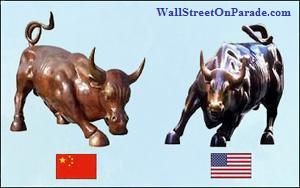By Pam Martens and Russ Martens: August 21, 2015
U.S. stocks felt their worst selloff in 18 months on Thursday with the Dow Jones Industrial Average losing 358 points and the S&P 500 index shaving off 43.88 points. Of particular concern, the S&P has now broken through its 200-day moving average which suggests to market technicians that more pain is ahead.
The stock plunge set off a flight to safety with money flowing into the 10-year U.S. Treasury note, driving down the yield. This morning, the U.S. 10-year paper is sporting a yield of 2.06 percent. Despite persistent talk of a rate hike coming out of the Federal Reserve, the yield on the 10-year has been declining for months, not rising – suggesting that the markets believe the Fed is reading the wrong tea leaves.
On the heels of the sea of red in U.S. markets yesterday, China’s stock markets sold off further Friday. The Shanghai Composite lost 4.3 percent while the Shenzhen was off by 5.4 percent. The ChiNext Price Index of smaller companies closed down 6.65 percent. It now appears that the Chinese government is only prepared to support stock prices to prevent an outright crash, but is not prepared to prop up the market on a daily basis. That would bleed its treasury coffers rather rapidly, given the extent of investors heading for the exits in China.
Adding to global worries, a preliminary Caixin/Markit China Manufacturing Purchasing Managers’ Index released on Friday showed further weakness in the Chinese economy. The Index for August came in with a reading of 47.1 versus July’s 47.8. There is growing conviction among economists that China is not growing at the officially declared rate of 7 percent, but at a rate considerably lower. The stock rout extended to Japan with its Topix 500 dropping 3.13 percent.
China is a major consumer of industrial commodities and its slowdown has added to the commodities glut and attendant sharp price declines in commodities. Oil and copper are now trading at prices last seen in the midst of the financial crisis.
China is also a major trading partner with the U.S. In 2014, the U.S. imported $466.7 billion of goods from China. Last week, China devalued its currency, meaning that the U.S. Dollar used by American consumers to purchase goods from China will now buy more of those goods at a lower price. That puts more downward pressure on inflation in the U.S. at a time when the Fed is already struggling to keep inflation from falling further.
The currency devaluation in China has set off a currency war in Asia as other countries must now devalue to make their exports competitive with those of China to protect market share.
Stock markets, particularly the U.S. stock market, view deflation as the worst possible of all economic outcomes as it is difficult to create purchasing demand when consumers believe that delaying a purchase will mean they can buy it at a cheaper price in the future because of deflationary forces. The central bank of the U.S., the Federal Reserve, has already been in the zero-bound range of interest rates since December 2008 and has no bullets left in its monetary policy gun to lower rates further should deflation set in. The Fed would be forced to resort to further rounds of quantitative easing at a time when its balance sheet has already ballooned to more than $4 trillion from prior rounds of QE.
The job to ward off deflation would fall to stimulus spending by the Federal government at a time when Republicans are demanding cuts in spending to balance the budget and shrink the national debt.
The U.S. stock market, which had appeared to be immune to the realities of what was happening in other markets, has suddenly opened its eyes. Clearly, it doesn’t like what it sees.


